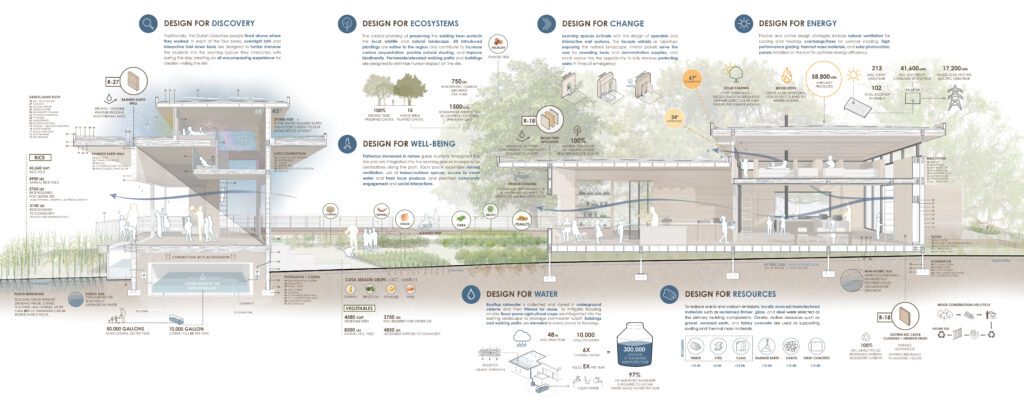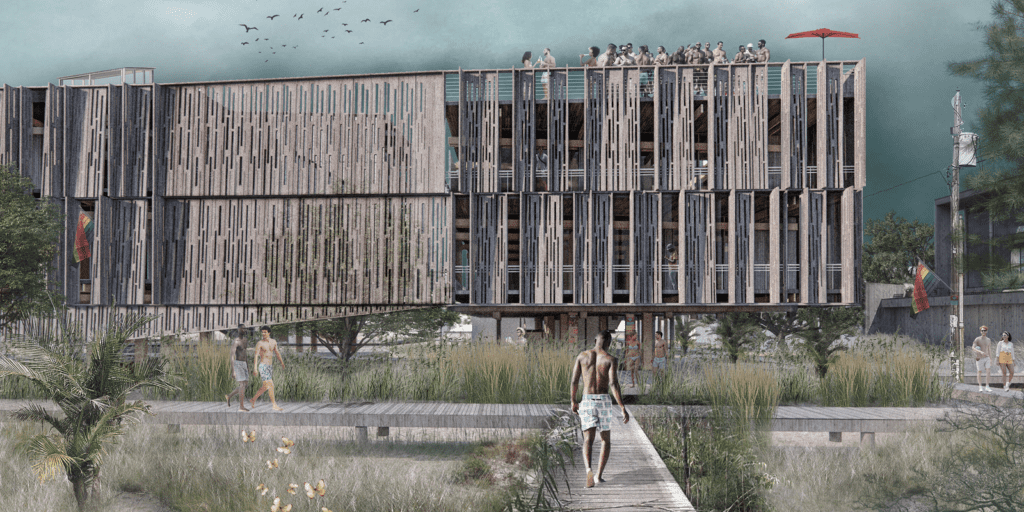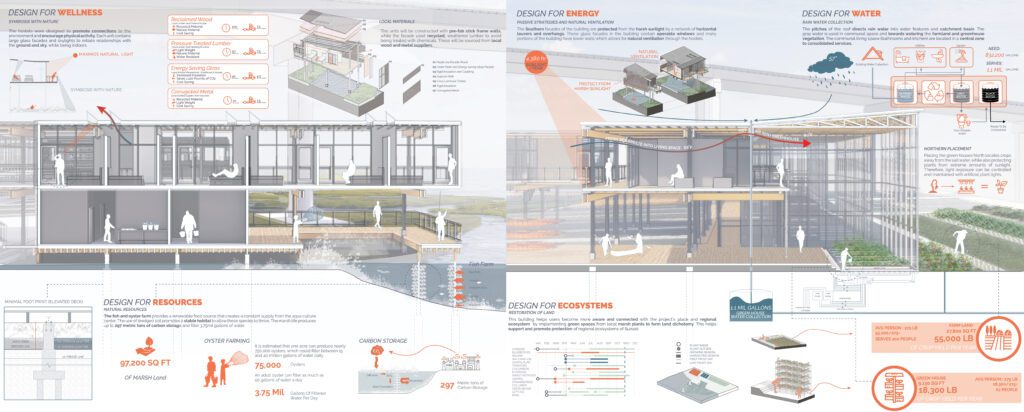
Clemson, SC
For the seventh year in a row, Clemson Master of Architecture (M.Arch) students were named among the winners of the American Institute of Architects, Committee on the Environment (AIA COTE), in partnership with the Association of Collegiate Schools of Architecture (ACSA), 2023 AIA COTE Top Ten for Students Competition, for environmentally sustainable design.
The COTE Top Ten competition winners were announced on August 24, 2023. Among the top ten proposals, three projects by Clemson students were declared winners: “The Craft, The Tradition, The Celebration of Culture,” “Restoring a Haven” and “Above The Marsh.” The proposals were completed in the Fall 2022 design studio taught by Associate Professor Ulrike Heine, Associate Professor David Franco, and Senior Lecturer George Schafer.
“We are excited to be recognized by the COTE Top Ten for the seventh consecutive year,” shared Jim Stevens, Director of Clemson’s School of Architecture. “The three recognized projects exemplify our dedication to design and sustainability.”
Development, tourism and traditions

One of this year’s winning proposals, “The Craft, The Tradition, The Celebration of Culture,” a project by Clemson M.Arch students Angela Kraus and Olivia Wideman, aimed to solve the disconnect between culture, place and estranged descendants through an immersive, hands-on learning center that celebrates the trades and traditions of the Gullah people through practice.

“This project challenged us to approach design holistically, purposefully, and with a strong sense of environmental responsibility,” explained Kraus. “The thoughtful interaction between the site, local ecology, community and culture was critical to the design. Through every iteration, critique, and milestone, our collaboration evolved, and so did our project, and we couldn’t be more grateful and excited to share this achievement.”
The proposed 12,670-square-foot school incorporates agriculture, cuisine, art and folklore as the four programmatic approaches to passing the trades and traditions of the Gullah people from locals to students of a seven-day heritage program. The proposal set the school on St. Helena Island as this location is one of the last South Carolina Sea Islands along the Gullah Geechee Heritage Corridor, where the Gullah still live and work.
“Being selected as one of the winning projects is a surreal accomplishment that wouldn’t have been possible without the support of our professors, whose guidance influenced us to immerse ourselves in the intricacies of our design fully,” said Wideman. “This project was not about creating appealing aesthetics, but celebrating the beauty of the culture, which manifested into something more beautiful than I could’ve imagined.”
Creative exploration through independent study

Another of this year’s winning proposals, “Restoring a Haven,” was designed by Clemson M.Arch students William Scott and Connor Smith. Their project aimed to provide space for creative exploration through an independent study project offered in the off-season and short-term housing opportunities for tourists during the peak season for The Pines Community in Fire Island, NY.

“As members of the LGBTQ+ community, Connor and I were immediately drawn toward The Fire Island Pines neighborhood as a potential site selection for our project,” explained Scott. “Known as one of the first openly queer-friendly vacation destinations, our intent was to take a deep dive into some of the societal, environmental and economic concerns facing Fire Island today to help influence our design strategies.”
Their program was geared to attract young, minority adults in the LGBTQ+ community to The Pines Community during the peak season by offering communal living spaces that can support up to 10 persons per unit, which allowed increased affordability and social interactions. Additionally, during the off-season, the units would transform into creative residencies.
According to the Jury, Smith and Scott’s design addresses the 10 Framework for Design Excellence measures. Their combination of design and quantitative information creating a compelling and thorough environmental solution.
“We really hoped our design would communicate our architectural response to social and environmental issues,” shared Smith. “It was a great surprise to find out we were among the ten winning projects, particularly with a year full of such strong submissions.”
Building relationships with the environment

Another of this year’s winning proposals, “Above The Marsh,” was designed by Clemson M.Arch students Lucas Schindler and Mia Walker. Schindler and Walker’s project introduces hostel live-work units to offer a flexible, economically viable option for travelers while supporting the community of Sunset Beach.

According to Walker, tourism can create unique pressures on local environments and communities, but architecture can catalyze positive social change. She explained that Sunset Beach, has experienced rising sea levels and erosion due to tourism and massive population fluctuations.
“We looked at tourism as a socially and environmentally problematic industry. This industry needed to formulate socially responsible, environmentally respectful, and economically sustainable alternatives,” shared Walker.
To combat the social and environmental issues caused by tourism, they designed hostel units with living quarters above the workspace. Which allowed for complete immersion in the live-work lifestyle.
“While the design of the building was important, it almost became secondary to the marshland and creating a farming experience on the protected site. We wanted the focus to be on the environmental aspects and design from the outside environment to the inside of the building,” said Schindler. “This would allow tourists to experience Sunset Beach and aspects of North Carolina in a manner that relates to the environment rather than harms the environment. Our professors were amazing help in this process and guided us through it as it was a different design process.”
Continued design success
With the continued success of Clemson’s architecture students in the COTE Top Ten awards, David Franco is hopeful that the School’s current students see this consistency as not only a high bar to reach, but also as the culture of the School’s community.
“It is an incredible joy for us as instructors to have students recognized in a highly competitive setting like COTE Top Ten for seven consecutive years,” shared Franco. “These awards demonstrate how architectural imagination can respond to climate change’s environmental and societal crisis with energy and even optimism.”
No Comments
Block this user
Are you sure you want to block this user and hide all related comments throughout the site?
Archinect
This is your first comment on Archinect. Your comment will be visible once approved.